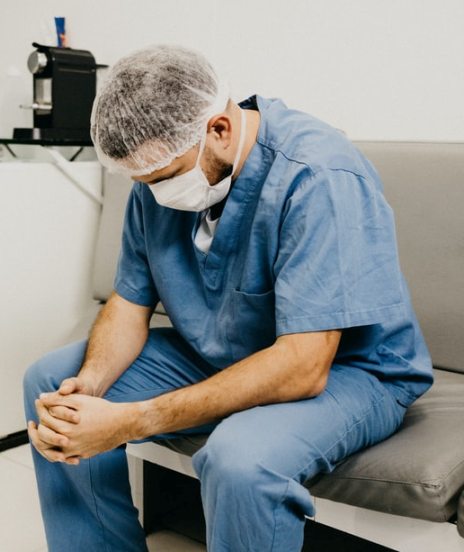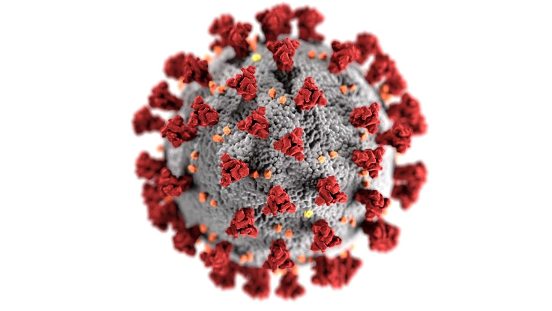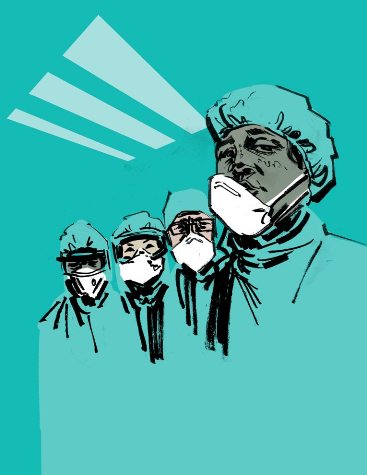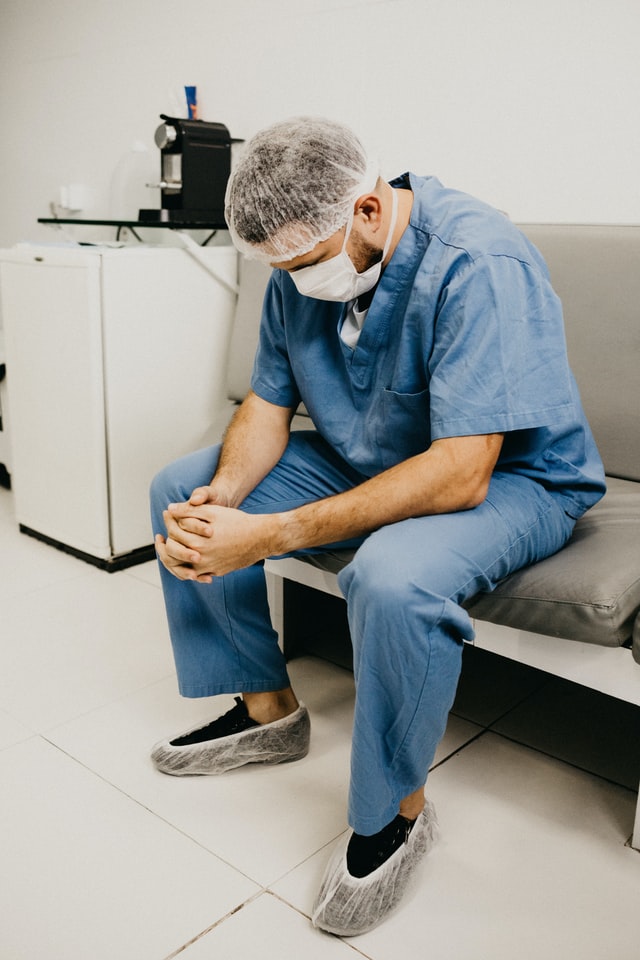Report Card for the Church: Response to COVID-19 and How to Do Better

This guest article by Christian historian William De Arteaga is not merely a historical and theological reflection. By way of introduction, he writes, “The end of the article contains specific, biblical ways of praying against viruses. I have done this for years with very good effect, but have not been allowed into a hospital to try it on COVID-19 patients. It would be great if some nurses and physicians (or even the cleaning crew) read this, prayed and anointed their patients in the manner I suggest. Let us see what miracles the Lord will work.”
One of my Facebook buddies recently commented that the COVID-19 virus was of demonic origins. Yes, it has done tremendous damage, economically and in taking many lives, including some in their prime of life. But it is problematic to call any created thing demonic. (I am assuming here that COVID-19 is a naturally occurring virus of animal origins and not from a Chinese lab as some believe.) Several years ago, my wife and I were giving a healing workshop, and a small roach meandered onto our book table. I disposed of it, but a lady nearby commented that she hated roaches and was sure that they were Satan’s creation.
Here we can definitely say, “no.” Roaches are part of God’s created order, even if we do not like them. When I see a roach in my kitchen I consider it a messenger telling me I have not disciplined myself on cleaning thoroughly or often enough. I say, “Thank you Mr. Roach, I will get to it, but if I see your sister I will spray the whole house.” Perhaps one of the roles of the COVID-19 virus is to remind the Church how poorly it is doing in its healing ministry after two thousand years. If I were a school teacher I would assign the Church a grade on the COVID-19 pandemic as a “C-,” barely passing.
Actually, God has provided Christians with means of countering infections from viruses and bacteria, and also the poisons of critters that sting like scorpions and spiders. The problem is that very few Christian know of this provision or take advantage of it. I will get to the specifics below.
The churches as a whole are still recovering from the long destructive period I have called “The Augustinian Consensus.” This was the period of the Church age when it functioned, by and large, without the gifts of the Spirit and did not know it had this deficit. Augustine of Hippo was a great theologian in many ways, as in explaining the idea of the Trinity for the Western Church, but like his contemporaries, he did not understand the functioning of the gifts of the Spirit as defined in the New Testament.
In the later years of his life he came to accept healing as part of the normal ministry of the Church, but never had a clue as to the other gifts of the Spirit as defined by St. Paul. Elsewhere I have explained how this lamentable situation arose and how it was compounded by later Catholic theology and especially by John Calvin’s theology of cessationism. Sadly, by the end of the Middle Ages, the Catholic Church stopped the laying on of hands for healing as a normal parish ministry and the anointing of oil for healing (James 5) was “spiritualized” as a safe passage past Purgatory.[1]
Various movements in the Church, from the Faith-Cure Movement (1880s) to Pentecostalism, to the Charismatic Movement, and the Anglican healing awakening have collectively regained most of the Church’s healing and Spirit-empowered ministries. However the situation is spotty and incomplete. That is, many churches, mostly Anglican, charismatic and Pentecostal, do have healing ministries within their churches with varying degrees of effectiveness.[2] But sadly, even many historic Pentecostal and charismatic churches still have very subdued healing ministries, as in only the pastor and a few in his staff, or a guest evangelist, doing healing prayer. The same is true of many “non-denominational” churches.
Let us see what miracles the Lord will work.
The recovery of healing prayer effectiveness is still going on and still faces opposition. In the last decade there has been a reactionary movement led by the prominent Bible teacher John MacArthur, whose immensely influential book Strange Fire, paints the gifts of the Spirit operating today as bogus.[4] Another example of resistance is the reluctance of many evangelicals to accept the ministry of deliverance/exorcism as needed for today. This continues to seriously hamper the effective healing ministry in many churches. In fact, every church that has an effective and robust healing ministry also does some deliverance/exorcism. This follows the Biblical pattern: Jesus and his disciples went around healing people, from both physical diseases or demonic disturbances, and sometimes both in the same person. (Lk 13:16) There was no separation of the ministries.
An example of the continued recovery of healing knowledge, one particularly important for the present discussion on the COVID-19 pandemic, is the recovery of “command healing.” That is, that all of the instances of healing and deliverance in the New Testament are shown as done by a command, as in “Stand up and walk.” or Ananias of Damascus saying to Paul, “Recover your sight” (Acts 22:12). This command mode of healing prayer was hidden in plain sight for centuries until pointed out by a humble Pentecostal couple Charles and Francis Hunter. Their books and evangelistic tours are largely responsible for showing this to the Church.[5] But they began doing this a mere forty years ago, and it is still resisted by some. Before that all the teaching and example given by the healing teachers was by way of prayers of petition, as in, “Father, in Jesus’ name, heal this arthritic knee.” That form of petition for healing is found in the Old Testament, as in the Psalms, but not in the New Testament. The change is that Jesus gave his disciples authority over disease and demons through the use of his name.
The recovery of healing prayer effectiveness is still going on and still faces opposition.
That response has been constantly carried out through the ages by devote clergy. Among many examples that could be cited was the ministry of several Episcopal nuns and priests, “The Memphis Martyrs,” who stayed in Memphis, Tennessee during the Yellow Fever epidemic of 1878, all of whom died during their ministry.[7] Many Catholic saints have been recorded in doing the same heroic “stay and minister” action.
However, there is no mention in these heroic accounts of these saints’ ministries that included healing prayer. So I grade these efforts with an “A” for love and courage, but an “F” on demonstrating the healing power of the Church. It evens out to a “C-.”
In truth, the response of the Church in America to the COVID-19 pandemic is filled with complexities, and I do not want to be overly critical for the various courses adopted by different ministers and pastors. The New Testament encourages obedience to civil authorities, so that a state or federal injunction against mass church services should normally be respected. Certain pastors have openly defied this, believing this a restriction of religious freedom and that the Lord will keep their congregation virus free.
Well maybe, but experience has proven otherwise in many cases. It has been to the sad reputation of the Church that occasionally some fundamentalist Pentecostals will refuse medication to a family member because that is “against faith” and the result is an unnecessary death. Here is an issue of “faith or presumption.”[8] A hypothetical example on the current pandemic: suppose a charismatic or Pentecostal church has a public service during the pandemic. Of the three hundred people attending only about ten have experience in the healing ministry, and most likely they are not sure as to how to specifically pray against a virus. Some in the group may sicken and die for lack of wisdom on praying against the virus. They have met presumptuously.[9]
The Church, even the Spirit-filled Pentecostal section of it, does not understand how to effectively pray to still a plague. Not that there have not been attempts at it. I have seen ministers prophesying and “judging” the virus, proclaiming it would disappear quickly. These ministers commanded a wave of warm weather across the United States to stop the spread of the virus, something that does disrupt the normal flu.
The following week a warm front did bring record highs over the Western and central parts of the country. But neither of these two prophetic moments left any noticeable effect. To the contrary, COVID-19 continues to spread in the United States, now in rural areas not hit before. Further, its continued spread in Africa and Latin America indicates that it will not subside because of warm weather.
I recall a report from years ago, when a coastal city in southern Europe was struck by an epidemic caused by eating contaminated shellfish. In response, the local bishop organized a procession in which the relics of a local saint were “uncovered” and processed around the city. This too was a sad exercise in futility.
In Acts we see the prophecy of a coming famine, but the church did not pray against it, but rather prepared for it in common-sense ways (Acts 11:27-30). Perhaps it is only possible to stop a virus plague by ministering prayer one person at a time. This may be God’s way of giving churches all over the world the opportunity of healing individual cases of the virus and witnessing to God’s mercy and power. Or there may be another way of praying and stopping a pandemic that we still do not know. We should not presume that we currently know everything about healing prayer.

An illustration of the coronavirus created at the Centers for Disease Control and Prevention (CDC).
So how can we pray effectively against viruses and specifically against the COVID-19 pandemic? For now, we can pray for one infected person at a time using biblical models.
So let us look at the biblical evidence. The word virus does not occur in the Bible, as no one knew about bacteria or viruses until relatively recent times. But the Bible mentions “fevers” several times, and specifically how Jesus healed people experiencing fevers. In the following incident Luke and Matthew give us complimentary accounts of how Jesus ministered to Peter’s mother-in law.
Jesus left the synagogue and went to the home of Simon. Now Simon’s mother-in-law was suffering from a high fever, and they asked Jesus to help her. So he bent over her and rebuked the fever, and it left her. She got up at once and began to wait on them (Luke 4:38-39).
When Jesus came into Peter’s house, he saw Peter’s mother-in-law lying in bed with a fever. He touched her hand and the fever left her, and she got up and began to wait on him (Matthew 8:14-15).
This is directly pertinent to the COVID-19 virus because we now know that most colds, flu and such are caused by viruses (sometimes bacteria). Viruses are very ancient, and so what was afflicting Peter’s mother-in-law was most likely a fever caused by a virus. Viruses that infect humans are all pretty much the same, whether polio, influenza, coronavirus, or something else. They are tiny globules that cannot exist by themselves but must find a host to replicate. So when Jesus came against the fever, He was really battling against a flu or cold virus of some sort.
Note that Jesus did two things. One, he touched her so that the healing energies of God would flow into her. He had done the same in many cases, including touching those with leprosy, whom everyone at the time recognized as contagious (Matt 8:1-3). The other thing was to speak healing, but in this case in the form of a rebuke to the fever (and underlying infectious agent).
Most Christian would be afraid to touch an infected person. But I believe that is the biblical pattern, and I would have no reluctance in doing so.
It is important to note the rebuke. A rebuke is of course given in the command mode. Although we do not have Jesus’ exact words, we can assume they were firm and not “nice” to the fever. We have his exact words when he cursed the fig tree to death:
Early in the morning, as Jesus was on his way back to the city, he was hungry. Seeing a fig tree by the road, he went up to it but found nothing on it except leaves. Then he said to it, “May you never bear fruit again!” Immediately the tree withered (Matt 21:18-20).

Image: Kevin Kobsic
In the current pandemic I have not had the opportunity to pray for a patient with COVID-19 directly. Hospitals are not allowing even chaplains to minister directly to such patients. But over the decades I have prayed for many persons with colds and the flu with good effect following the command mode. I do that to myself when I feel the beginning of an illness such as a scratchy throat or drippy nose. I stand in front of a mirror and command: “In Jesus name, whatever virus or bacteria is infecting me die and disintegrate now!” I add an encouragement to my immune system, “Immune system, be strong and completely throw out whatever is infecting me.” I can truthfully say that in the past decade, using this command mode of prayer/curse, I have not had to take a sick day from work. I have prayed this over friends with the flu and it seems they recover much quicker.
Of course, this does not exhaust other forms of healing prayer for virus illness. James 5 encourages the elders of the church to anoint the sick with oil so that they will recover. It makes no distinction as to “fevers” (viruses) or other types of illnesses. I generally carry a small vessel of blessed oil, and many times when I pray for someone ill I finish with anointing the person’s forehead in the sign of the cross.
I am hopeful that the command mode of healing prayer continues to spread among Christians so that the Church will be better equipped to stem the next pandemic and earn a possible “B” or “B+” grade. There will always be churches that are stubborn and will not change the way they operate. They will say, “We never did such foolishness as cursing a virus, so why should we start now?”
I promised to talk about the way to stop insect sting poisons, and let me do that here. It is by command mode. The first time I used it was perhaps twenty years ago when I was walking on a wooded trail with my wife in the mountains of north Georgia. She has always been highly allergic to bee stings, and wham, she got stung by a yellow jacket. She did not have the packet of Benadryl she usually carries with her. We had just learned the command mode of prayer so I went right to it. “In Jesus’ name, I speak to the enzymes and poisons [injected by the bee] and command they disintegrate harmlessly, NOW! In Jesus’ name I command the [bee sting] bump to contract and the skin to go back to normal.” By the time we returned home ten minutes later, there was no sign of the sting and my wife did not have to take the usual Benadryl.
James 5 encourages the elders of the church to anoint the sick with oil so that they will recover.
Let me construct a situation that might play out several years from now:
The church pastor gets a phone call that one of his church members, Mrs. Smith at 105 Elm St., has the first symptoms of COVID-25 virus, confirmed by the app on her smart watch. The Pastor considers how to minister to this and it occurs to him, “Oh, Mrs. Hernandez, of our healing team, lives nearby. I’ll give her a call.” Subsequently Mrs. Hernandez and one of her friends on the healing team arrive at Mrs. Smith’s home. They go in and anoint her with blessed oil, lay hands on her, rebuke the virus, and then speak strength to her immune system. They wash their hands and leave. Mrs. Smith goes to sleep and when she awakes three hours later, her symptoms are completely gone. The smart watch tells her she is no longer infected.

Image: Jonathan Borba
Church, do this. Let’s aim for a “B” in the next pandemic.
PR
Notes
[1] I explain how the Church became gifts deficient in both my earlier work, Quenching the Spirit (Lake Mary, Creation House, 1996) and my more recent one, Agnes Sanford and her Companions ( Eugene: Wipf & Stock, 2015).
[2] An example of just how effective a church’s healing ministry can be is shown in my article on the Falls Church Anglican Church, “Falls Church Anglican: The Long March to Healing Excellence,” Pneuma Review, posted April 19, 2020. http://pneumareview.com/the-falls-church-anglican-the-long-march-to-healing-ministry-excellence/
[3] See my work Quenching the Spirit, on this issue.
[4] John MacArthur, Strange Fire (Thomas Nelson, 2013). Note the very fine responses to MacArthur’s awful hermeneutics by various authors in Pneuma Review, especially Craig S. Keener’s review, “John MacArthur’s Strange Fire,” posted Nov. 15, 2013. http://pneumareview.com/john-macarthurs-strange-fire-reviewed-by-craig-s-keener/
[5] William De Arteaga, “The Happy Hunters’ Revolution in Healing Prayer,” Pentecostal Theology, posted Oct 12, 2019. Recovered from a blog posted on Blogger but removed along with all of my blogs as “contrary to community standards.” http://www.pentecostaltheology.com/the-happy-hunters-revolution-in-healing-prayer/
[6] Emmy Yang, “What Martin Luther Teaches Us About Coronavirus,” Christianity Today, posted Jan. 20, 2020. https://www.christianitytoday.com/ct/2020/january-web-only/martin-luther-coronavirus-wuhan-chinese-new-year-christians.html
[7] Michael Finger, “The Martyrs of Memphis,” Memphis Magazine, posted April 8, 2019. https://memphismagazine.com/features/the-martyrs-of-memphis/
[8] The classic on this is Charles Farah’s, From the Pinnacle of the Temple (Plainsfield: Logos International, 1979).
[9] The church that I have mentioned above, Falls Church Anglican, has prudently cancelled its services and may not open for a while.
Category: Ministry, Spring 2020


